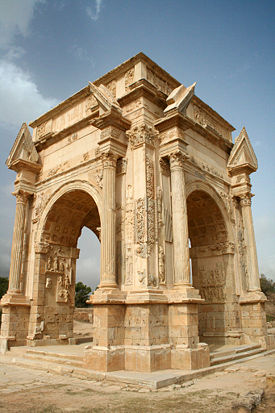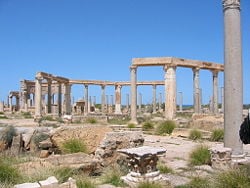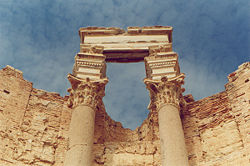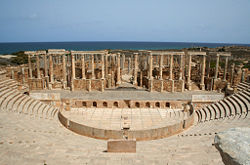Difference between revisions of "Leptis Magna" - New World Encyclopedia
Mary Anglin (talk | contribs) |
Mary Anglin (talk | contribs) |
||
| Line 17: | Line 17: | ||
== History == | == History == | ||
| − | Leptis Magna was largest city of the ancient region of [[Tripolitania]], located on the coast of the [[Mediterranean Sea]] in what is now [[Libya]]. The present-day city of [[Al-Khums]] is located 2 miles west of the ancient site. | + | ===Ancient history=== |
| + | Leptis Magna was the largest city of the ancient region of [[Tripolitania]], located on the [[North Africa]]n coast of the [[Mediterranean Sea]] in what is now [[Libya]]. The present-day city of [[Al-Khums]] is located 2 miles west of the ancient site. <ref name=EB> ''Encyclopædia Britannica Online''. 2008. [http://www.britannica.com/eb/article-9047868 Leptis Magna] Retrieved April 23, 2008. </ref> | ||
| − | + | The city is believed to have been founded by [[Phoenicians]] of [[Tyre]] or [[Sidon]] in approximately the 10th century B.C.E. Carthaginians later settled in Leptis Magna around the end of the 6th century B.C.E. Within one hundred years it had become prominent as [[Carthage]] became a major power in the Mediterranean. Its harbor at the mouth of the Wadi Labdah placed it in a prime position as a Mediterranean and trans-Saharan trade center. The thriving [[agriculture]] in the fertile coastal region turned Leptis Magna into an important market center. | |
| − | The city | ||
[[Image:Leptis Magna market place April 2004.jpg|thumb|left|250px|Market place]] | [[Image:Leptis Magna market place April 2004.jpg|thumb|left|250px|Market place]] | ||
[[Image:Leptis_Magna_B2.jpg|thumb|left|250px|Severan Basilica]] | [[Image:Leptis_Magna_B2.jpg|thumb|left|250px|Severan Basilica]] | ||
[[Image:Leptis_Magna_Theatre.jpg|thumb|left|250px|Theater]] | [[Image:Leptis_Magna_Theatre.jpg|thumb|left|250px|Theater]] | ||
| − | |||
| − | Leptis achieved its greatest prominence beginning in 193, when a native son, Lucius [[Septimius Severus]], became [[Roman Emperors|emperor]]. He favored his hometown above all other provincial cities, and the buildings and wealth he lavished on it made Leptis Magna the third most-important city in Africa, rivaling Carthage and [[Alexandria]]. | + | It became a Punic city, passing to Masinissa's [[Numidian kingdom]] in 202 B.C.E. It eventually broke away and became an ally of Rome, becoming a part of the new Roman province of Africa around 23 B.C.E., although from about 200 B.C.E. onward it was for all intents and purposes an independent city. It retained a number of its Punic legal and cultural traditions, including its municipal constitution and the official use of the Punic language. <ref name=EB /> It soon prospered and became one of the leading cities of Roman Africa and a major trading post. |
| + | |||
| + | Leptis achieved its greatest prominence beginning in 193, when a native son, Lucius [[Septimius Severus]], became [[Roman Emperors|emperor]]. He favored his hometown above all other provincial cities, and the buildings and wealth he lavished on it made Leptis Magna the third most-important city in [[Africa]], rivaling [[Carthage]] and [[Alexandria]]. Under Severus' direction an ambitious building program was initiated, including the creation of a new forum and the rebuilding of the docks and harbor. | ||
| + | |||
| + | Soon Leptis overextended itself and began to decline due in part to increasing insecurity of the frontiers. As a part of Roman Africa, it was affected by what became known as the ''Crisis of the Third Century'' - the crumbling and near collapse of the [[Roman Empire]] between 235 and 284. This was caused by three simultaneous crises: external invasion, internal [[civil war]], and economic collapse. The changes in the institutions, society, economic life and eventually [[religion]] were so profound and fundamental, that the this period is increasingly seen as the watershed marking the difference between the [[Classical antiquity|classical world]] and the early [[medieval]] world, or world of [[late antiquity]]. | ||
| + | |||
| + | With this instability in the [[Roman Empire|Empire]], Leptis Magna's importance also fell into a decline, and by the middle of the fourth century, large parts of the city had been abandoned and fell into ruin. | ||
| − | + | The historian [[Ammianus Marcellinus]] recounts that the crisis was worsened by a corrupt Roman governor named [[Romanus]] during a major tribal raid who demanded bribes to protect the city. The ruined city could not pay these, and complained to the emperor [[Valentianian]]. Romanus then bribed people at court and arranged for the Leptan envoys to be punished 'for bringing false accusations'. It enjoyed a minor renaissance beginning in the reign of the emperor [[Theodosius I]]. | |
| − | Leptis | + | In 439, Leptis Magna and the rest of the cities of [[Tripolitania]] fell under the control of the [[Vandals]] when their king, [[Gaiseric]], captured Carthage from the Romans and made it his capital. Unfortunately for the future of Leptis Magna, Gaiseric ordered the city's walls demolished so as to dissuade its people from rebelling against Vandal rule. But the people of Leptis and the Vandals both paid a heavy price for this in 523, when a group of [[Berber]] raiders sacked the city. |
| − | + | [[Belisarius]] recaptured Leptis Magna in the name of Rome 10 years later, and in 534 he destroyed the kingdom of the Vandals. Leptis became a provincial capital of the Eastern Roman Empire, but never recovered from the destruction wreaked upon it by the Berbers. It was the site of a massacre of Berber chiefs by the Roman authorities in 543. <ref> "Leptis Magna," Catholic Encyclopedia. </ref> By the time of the [[Arab]] conquest of Tripolitania in the 642, the city was abandoned except for a Byzantine garrison force. | |
| − | |||
| + | ===Modern history=== | ||
Today, the site of Leptis Magna is the site of some of the most impressive ruins of the Roman period. | Today, the site of Leptis Magna is the site of some of the most impressive ruins of the Roman period. | ||
Revision as of 03:54, 24 April 2008
| Archaeological Site of Leptis Magna* | |
|---|---|
| UNESCO World Heritage Site | |

| |
| State Party | 22px Libyan Arab Jamahiriya |
| Type | Cultural |
| Criteria | i, ii, iii |
| Reference | 183 |
| Region** | Arab States |
| Inscription history | |
| Inscription | 1982 (6th Session) |
| * Name as inscribed on World Heritage List. ** Region as classified by UNESCO. | |
Leptis Magna, also known as Lectis Magna (or Lepcis Magna as it is sometimes spelled), also called Lpqy or Neapolis, was a prominent city of the Roman Empire. Its ruins are located in Al Khums, Libya, 130 km east of Tripoli, on the coast where the Wadi Lebda meets the sea. The site is one of the most spectacular and unspoilt Roman ruins in the Mediterranean.
History
Ancient history
Leptis Magna was the largest city of the ancient region of Tripolitania, located on the North African coast of the Mediterranean Sea in what is now Libya. The present-day city of Al-Khums is located 2 miles west of the ancient site. [1]
The city is believed to have been founded by Phoenicians of Tyre or Sidon in approximately the 10th century B.C.E. Carthaginians later settled in Leptis Magna around the end of the 6th century B.C.E. Within one hundred years it had become prominent as Carthage became a major power in the Mediterranean. Its harbor at the mouth of the Wadi Labdah placed it in a prime position as a Mediterranean and trans-Saharan trade center. The thriving agriculture in the fertile coastal region turned Leptis Magna into an important market center.
It became a Punic city, passing to Masinissa's Numidian kingdom in 202 B.C.E. It eventually broke away and became an ally of Rome, becoming a part of the new Roman province of Africa around 23 B.C.E., although from about 200 B.C.E. onward it was for all intents and purposes an independent city. It retained a number of its Punic legal and cultural traditions, including its municipal constitution and the official use of the Punic language. [1] It soon prospered and became one of the leading cities of Roman Africa and a major trading post.
Leptis achieved its greatest prominence beginning in 193, when a native son, Lucius Septimius Severus, became emperor. He favored his hometown above all other provincial cities, and the buildings and wealth he lavished on it made Leptis Magna the third most-important city in Africa, rivaling Carthage and Alexandria. Under Severus' direction an ambitious building program was initiated, including the creation of a new forum and the rebuilding of the docks and harbor.
Soon Leptis overextended itself and began to decline due in part to increasing insecurity of the frontiers. As a part of Roman Africa, it was affected by what became known as the Crisis of the Third Century - the crumbling and near collapse of the Roman Empire between 235 and 284. This was caused by three simultaneous crises: external invasion, internal civil war, and economic collapse. The changes in the institutions, society, economic life and eventually religion were so profound and fundamental, that the this period is increasingly seen as the watershed marking the difference between the classical world and the early medieval world, or world of late antiquity.
With this instability in the Empire, Leptis Magna's importance also fell into a decline, and by the middle of the fourth century, large parts of the city had been abandoned and fell into ruin.
The historian Ammianus Marcellinus recounts that the crisis was worsened by a corrupt Roman governor named Romanus during a major tribal raid who demanded bribes to protect the city. The ruined city could not pay these, and complained to the emperor Valentianian. Romanus then bribed people at court and arranged for the Leptan envoys to be punished 'for bringing false accusations'. It enjoyed a minor renaissance beginning in the reign of the emperor Theodosius I.
In 439, Leptis Magna and the rest of the cities of Tripolitania fell under the control of the Vandals when their king, Gaiseric, captured Carthage from the Romans and made it his capital. Unfortunately for the future of Leptis Magna, Gaiseric ordered the city's walls demolished so as to dissuade its people from rebelling against Vandal rule. But the people of Leptis and the Vandals both paid a heavy price for this in 523, when a group of Berber raiders sacked the city.
Belisarius recaptured Leptis Magna in the name of Rome 10 years later, and in 534 he destroyed the kingdom of the Vandals. Leptis became a provincial capital of the Eastern Roman Empire, but never recovered from the destruction wreaked upon it by the Berbers. It was the site of a massacre of Berber chiefs by the Roman authorities in 543. [2] By the time of the Arab conquest of Tripolitania in the 642, the city was abandoned except for a Byzantine garrison force.
Modern history
Today, the site of Leptis Magna is the site of some of the most impressive ruins of the Roman period.
New discoveries
In June 2005 it was revealed that archaeologists from the University of Hamburg had been working along the coast of Libya when they uncovered a 30 ft length of five colorful mosaics created during the 1st or 2nd century. The mosaics show with exceptional clarity depictions of a warrior in combat with a deer, four young men wrestling a wild bull to the ground, and a gladiator resting in a state of fatigue, staring at his slain opponent. The mosaics decorated the walls of a cold plunge pool in a bath house within a Roman villa at Wadi Lebda in Leptis Magna. The gladiator mosaic is noted by scholars as one of the finest examples of representational mosaic art ever seen — a "masterpiece comparable in quality with the Alexander mosaic in Pompeii." The mosaics were originally discovered in 2000, but were kept secret to avoid looting. They are currently on display in the Leptis Magna Museum.[3]
Notes
- ↑ 1.0 1.1 Encyclopædia Britannica Online. 2008. Leptis Magna Retrieved April 23, 2008.
- ↑ "Leptis Magna," Catholic Encyclopedia.
- ↑ Alberge, Dalya, "Roman Mosaic 'Worthy of Botticelli", The Times Online, June 2005. Retrieved December 20, 2007.
ReferencesISBN links support NWE through referral fees
- Talbert, Richard J. A., and Roger S. Bagnall. Barrington Atlas of the Greek and Roman World. Princeton, N.J.: Princeton University Press, 2000. ISBN 069103169X
External links
All links Retrieved December 20, 2007.
- Comprehensive website, by an archaeologist working on the site
- The Circus at Leptis Magna - Satellite View Google Maps
Credits
New World Encyclopedia writers and editors rewrote and completed the Wikipedia article in accordance with New World Encyclopedia standards. This article abides by terms of the Creative Commons CC-by-sa 3.0 License (CC-by-sa), which may be used and disseminated with proper attribution. Credit is due under the terms of this license that can reference both the New World Encyclopedia contributors and the selfless volunteer contributors of the Wikimedia Foundation. To cite this article click here for a list of acceptable citing formats.The history of earlier contributions by wikipedians is accessible to researchers here:
The history of this article since it was imported to New World Encyclopedia:
Note: Some restrictions may apply to use of individual images which are separately licensed.


